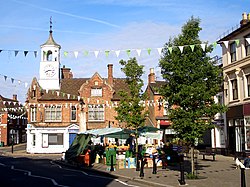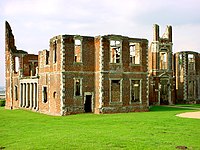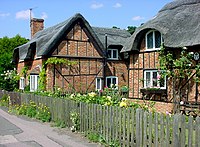Ampthill
| Ampthill | |
| Bedfordshire | |
|---|---|
 Ampthill town centre | |
| Location | |
| Grid reference: | TL035375 |
| Location: | 52°1’35"N, 0°29’26"W |
| Data | |
| Population: | 6,767 (2001) |
| Post town: | Bedford |
| Postcode: | MK45 |
| Dialling code: | 01525 |
| Local Government | |
| Council: | Central Bedfordshire |
| Parliamentary constituency: |
Mid Bedfordshire |
Ampthill is a small town in Bedfordshire, sitting Bedford and Luton. It has a modest, of about 6,000. A regular market has taken place on Thursdays for centuries.
The name 'Ampthill' is of Old English origin and the town appears to have first named Æmethyll, which literally means 'ant hill'.
History
In the Domesday Book of 1086, Ampthill is referred to as Ammetelle, and it records that the manor was held by Nigel de la Vast.
In 1242, King Henry III confirmed to the town the right to hold a market on Thursdays, and these continue more than 750 years later.
The castle at Amptill was built in the 15th century by Sir John Cornwall, later Lord Fanhope, from ransoms he accumulated after the Battle of Agincourt. Although the Castle is now gone, some intriguing indications of castle life remain, such as the local ponds (amongst them Westminster pond) dug to supply the castle with regular supplies of fish.
Henry VIII was a frequent visitor to Ampthill Castle, and it was there that Catherine of Aragon lived from 1531 until the marriage was annulled in 1533, after which she was moved to Kimbolton in Huntingdonshire.
Parish church
The church of St Andrew ranges in date from Early English to Perpendicular.
Within the church is a monument to Richard Nicolls (1624–1672), an Ampthill native who in 1664 received the submission of New Amsterdam, the chief city of New Netherland, the Dutch colony in North America. King Charles II had granted New Netherland in advance to his briother the Duke of York (later King James II), and it was under the Duke of York's patronage that Nicolls took the Dutch surrender and became the first English governor. The town was renamed "New York".[1] Nicolls perished in the action between the English and Dutch fleets at Solebay, and the ball which killed him is preserved on his tomb.
The church also contains a ring of eight bells. There were six until 1981, when the two new bells were installed. Services Run weekly, with Sung Eucharist at 9.30AM and Evensong at 6.30PM. The church has a regular 4 part choir, which has sung morning and evening services for over 100 years.
Houghton House

Houghton House was built in 1621 by Mary, Countess of Pembroke, sister of the poet Sir Philip Sidney. In 1675, so it is said, the house provided the inspiration for 'House Beautiful' in John Bunyan's The Pilgrim's Progress, whose locations though figurative of the journey though life, may have drawn shape from Bunyan's journey between Bedford and Luton; the steep slope leading into Ampthill suggests the 'Hill Difficulty'.
Houghton House passed to the Duke of Bedford in 1738 and became a ruin after the removal of the roof in 1794.
Shaping the town

In the mid-1780s, John Fitzpatrick, the 2nd Earl of Upper Ossory, led a campaign to improve the town centre. He created the current market place, erected the water pump and built a new clock tower. Lord Upper Ossory was also responsible for a cross commemorating Katherine of Aragon, with an inscription by Horace Walpole, and a row of thatched cottages built between 1812 and 1816 to house his estate workers.
On the death of Lord Upper Ossory in 1818, Ampthill Park became the seat of Lord Holland in whose time Holland House in Kensington, Middlesex, became famous as a gathering place for intellectuals.
Notable 20th century architect Sir Albert Richardson lived in Ampthill from 1919 until his death in 1964 at Avenue House, 20 Church Street. Among his last projects was the building that housed the Ampthill Rural District Council offices and its successor until August 2006,.
Ampthill Park was the burial place for the golden hare in the Kit Williams treasure hunt Masquerade.
During WWII there was a farming camp near Ampthill where volunteers recovered sugarbeet and were accommodated in tents in the grounds of a nearby country mansion.
Ampthill today
Ampthill still trades on its "historic market town" reputation, serving as a commercial centre for surrounding villages. The town has several lively pubs, a wide variety of restaurants, a supermarket and a selection of small independent specialist shops below flats. A number of small businesses such as solicitors, estate agents, financial services, hairdressers, music schools and a bookshop are also located in town, with larger businesses to be found on the commercial and industrial developments on the outskirts, along the town's bypass. Ampthill also has a high concentration of public amenities, including schools, doctors surgeries, fire and ambulance stations, and a police station.
Ampthill's historic centre, coupled with well-respected schools and the facilities mentioned above has made it one of the most expensive places to buy a house in Bedfordshire, even in comparison to other mid-Bedfordshire towns such as neighbouring Flitwick, and Cranfield. In a survey,[2] it was found that the majority of Ampthill's workers are employed locally, with around 20% working in Ampthill itself, and most of the remainder travelling to nearby centres of employment such as Bedford, Luton and Milton Keynes. It is possible to commute from Ampthill to London, and around 13% of workers make this journey daily. The survey also found that the turnover of residents was low, most having been in Ampthill for well over a decade.
Sport and leisure

- Cricket: Ampthill Town Cricket Club, established in 1890. They also host a county game once a year and host an annual friendly game with London Zoo. Their home is in Ampthill Great Park with a magnificent clubhouse and scorebox near the west carpark.
- Football: Ampthill Town FC play at Ampthill Park
Outside links
| ("Wikimedia Commons" has material about Ampthill) |
- Ampthill Info - Town Information Website
- Ampthill Shops & Businesses Website
- Ampthill Good Neighbours Scheme Website
- Ampthill Festival Website
- Ampthill Town Council Website
- Ampthill Town Forum
- Town's History Site
- Ampthill Bell Ringers Website
- St Andrew's Church of England
- Ampthill Town Band
- Ampthill TV
- Ampthill Weather Station
- Ampthill Images
References
- ↑ Who Was Who in America, Historical Volume, 1607-1896. Chicago: Marquis Who's Who. 1963.
- ↑ Ampthill.org.uk
